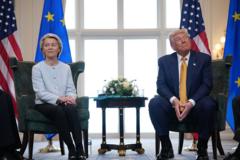Despite cheers for the EU-US trade agreement reached after lengthy negotiations, Europe is not celebrating too loudly. EU Commission chief Ursula von der Leyen and former US President Donald Trump initially sparked hope by avoiding a 30% tariff that could have devastated trade. However, many European leaders are now expressing dissatisfaction, fearing the 15% tariffs enacted on exports to the US are still detrimental.
The deal may have created some predictability, but not all terms are set in stone, raising alarms among EU countries about uneven repercussions from the new rates. German Finance Minister Lars Klingbeil acknowledged that while a tougher stance would have been ideal, an agreement at least provides some security, though the rising tariff marks a significant jump from the previous 4.8% average.
In addition, key discrepancies between the EU and US claims regarding various sectors have emerged. The US suggests pharmaceuticals and semiconductors fall under the 15% rate, while the EU contends they maintain a 0% tariff until new agreements are established. There's also contention over investments and military expenditures, with the future of several trade negotiations clouded in ambiguity.
Countries like Germany, Ireland, and Italy stand to lose significantly due to their ties with the US, with the automotive, pharmaceutical, and agricultural sectors feeling the strain. The Italian Institute of International Political Studies warns that Italy's GDP may take a hit as compensation demands could burden taxpayers and give President Trump a win at Europe's expense.
As discussions persist, European negotiators are under mounting pressure to secure a more favorable outcome and safeguard their nations' economic interests.
The deal may have created some predictability, but not all terms are set in stone, raising alarms among EU countries about uneven repercussions from the new rates. German Finance Minister Lars Klingbeil acknowledged that while a tougher stance would have been ideal, an agreement at least provides some security, though the rising tariff marks a significant jump from the previous 4.8% average.
In addition, key discrepancies between the EU and US claims regarding various sectors have emerged. The US suggests pharmaceuticals and semiconductors fall under the 15% rate, while the EU contends they maintain a 0% tariff until new agreements are established. There's also contention over investments and military expenditures, with the future of several trade negotiations clouded in ambiguity.
Countries like Germany, Ireland, and Italy stand to lose significantly due to their ties with the US, with the automotive, pharmaceutical, and agricultural sectors feeling the strain. The Italian Institute of International Political Studies warns that Italy's GDP may take a hit as compensation demands could burden taxpayers and give President Trump a win at Europe's expense.
As discussions persist, European negotiators are under mounting pressure to secure a more favorable outcome and safeguard their nations' economic interests.



















